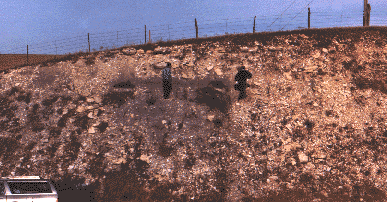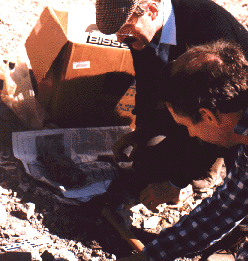
In
June and July of 1996, Dr. Igor Novikov, deputy director of
the
Paleontological Institute visited City Museum-then under
construction.
In as much as he was a Permian-Triassic amphibian expert, it behooved
us
to cater to his interests. We organized an excavation in eastern Kansas
(remniscent
of the steppes of Kazahkstan) where there was an outcrop
of
Permiam mudstone exposed by a roadcut.
Also in attendance was Nikolai
Kalandadze and Irena Sergenkova of the
Paleontological
Institute and various hangers-on.
It was 100°+ and within a few hours the Russians
were burnt to a cisp.
Fortunately within the first ten minutes, Nick pointed to
a shallow depression and
suggested we dig there. Voila, a small skull of a creature
which appeared
to be a Diplocaulus. For the uninitiated, this is the amphibian
always
seen in the lay literature with the boomerang head.
It is approximately
280 million years old.
This
specimen was returned to Moscow where it was presented to
Dr.
Yuri Gubin (also amphibian specialist) for preparation.
After it was fully
prepared, Dr. Gubin ventured that it was a new species.
After
further examination, Dr. Gubin felt that perhaps the skull might
represent
a new genus as well. Yuri traveled to Chicago to
meet with Dr. John Bolt, Director
of Paleontology at the
Field Museum and who is generally recognized as the
authority
on Diplocaulus. Results are awaiting further consultation.
In the meantime, a
second expedition was organized to the same
location in the dead of winter (December
19, 1997).
Here
Dr. Gubin (in hat) is packing away one of five full skeletons
excavated
on that expedition.
We are still awaiting the results of Dr. Gubin's
analysis.
Suffice it to say, Dr. Gubin was excited enough
by these finds
he endeavored to leave all his personal possessions in America
so
he wouldn't have to pay excess baggage charges to carry home his new finds.
A
very nice Christmas indeed for Dr. Gubin.
Since then Dr. Gubin has pronounced it a new species and genus and named it
Ductilodon pruittii and published his results.
